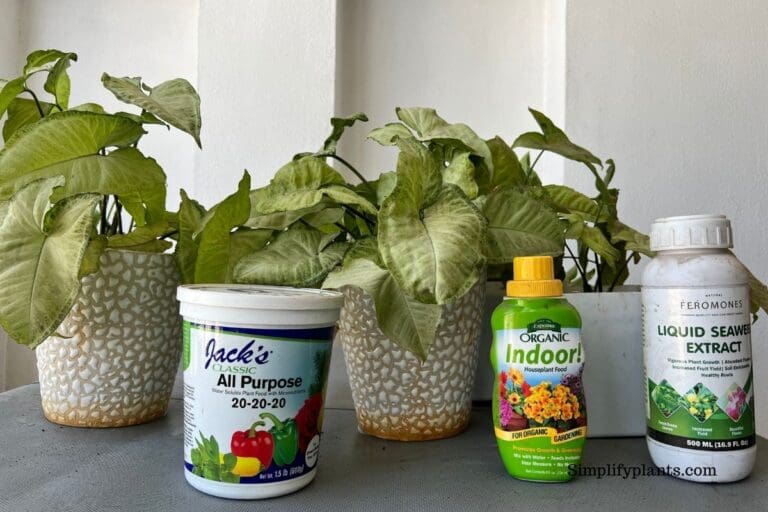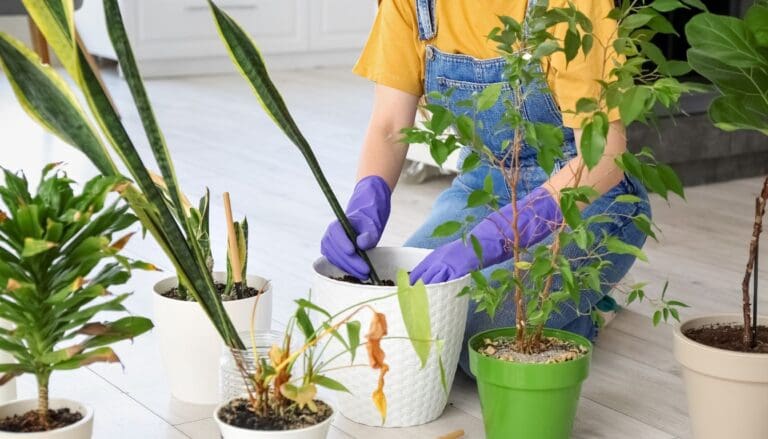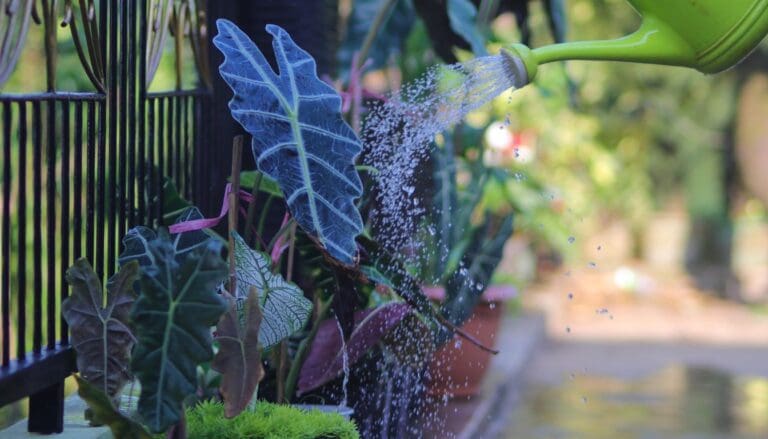Schefflera Watering Guide: How Much, How Often, How To & More!
Schefflera plant (Umbrella Plant) is an extremely popular houseplant that comes in multiple variants and is one of the favorites among houseplant lovers because they do not need a lot of maintenance. If you are wondering how much water does Schefflera plant needs, stick around.
In general, Schefflera requires water every 5-10 days, depending on the temperature and humidity around the plant. You should water the plant whenever the soil gets 75% dry. While watering, always water your Schefflera plant thoroughly until water starts coming out of the drainage holes.
In this article, we will discuss everything about the Umbrella plant’s water requirements and explain how your watering technique should change with season and temperatures.

Please note: Simplify Plants is reader-supported. Some links in the post are affiliate links and I get a commission from purchases made through links in the post.
Schefflera plant watering requirements
Schefflera plants are native to Taiwan and belong to the Araliaceae family.
And they enjoy lightly moist soil and do not like being bone dry or extremely wet for a long time.
When it comes to water requirements for Schefflera, or the umbrella plant as they are popularly called, the season and temperature play the most important role.
The watering needs of every plant depend on how hot or cold it is.
So your watering schedule cannot be the same throughout the year.
Now let us discuss how often you should water your Umbrella plant each season.
Summer
Spring and summer are when the weather is the hottest, and your umbrella plant grows the most.
From April to September, the plant grows the most; hence its watering needs are the highest.
Due to the scorching heat and light, the evaporation and transpiration rates are higher, making the plant need a lot of water.
Hence in this growing season, the water you give to your plant is absorbed faster as the sun shines brightly.
So you must water your Schefflera plant thoroughly when the soil is around 75% dry.
Water it fully until you see it draining out of the holes.
The soil of the Schefflera must be kept evenly moist at all times in summers but not soggy.
Remember to empty the saucer or plates at the bottom that hold the water, leading to fungus growth in the soil.
Instead of following a set pattern, check the soil’s moisture content yourself to understand whether it needs water.
Schefflera, being hardy plants, can tolerate under-watering for a while.
However, if you keep it bone dry for too long, it might get weak and dehydrated.
Winter
Winter and fall are when your Schefflera needs the least amount of water.
The plant employs the least energy in growth during this time.
Its growth remains stagnant, the sunlight is mild, and a very low evaporation rate.
The less intensity of sunlight, low humidity levels, low temperature, and the shorter day span give your plant hard times, so they grow less and mostly stay dormant.
During this time, the plant invests less energy in growing, so it absorbs less water, too, so you must also water your umbrella plant less during falls and winter and wait for the soil to get dry between watering.
Remember Schefflera plants are prone to overwatering, so always check the soil between watering.
Also, remember not to use too freezing cold water.
Instead, use room temperature water for your plant to avoid shock to the plant.
How do I understand if my Schefflera needs water?

We often do not understand whether the plant needs water or not, and water even when it does not require it.
This often leads to overwatering problems in the plants resulting in fungus growth and a sick plant.
So let us discuss the various ways by which you can figure out if your plant requires water.
Finger test: The easiest way to understand whether your plant requires water or not is by doing the finger test.
You have to dip your finger 2inches- to 3 inches inside the soil.
If the soil sticks to your finger, it means the soil still has moisture.
And you must not water it.
But if the soil feels dry and does not stick to your skin, you can water your Schefflera plant.
Moisture meter: Moisture meters are the best thing to get your answer for those who want to be scientifically sure before watering your Schefflera plant or do not wish to dirty your hand.
This is the most reliable way to understand the moisture content of your plant.
You need to gently insert the moisture meter into the soil around the base of the plant, and the readings on the meter will tell you the moisture content of the soil.
If the reading on the meter is around 2 or 3, you can water the plant.
Touching the pot: Another way to understand the plant’s moisture level is by touching the pot.
If your Schefflera grows in a terracotta pot, it would feel damp on the sides, and the bottom of the soil has moisture when you touch the pot.
However, if it is dry means the soil inside has no more moisture in it.
Looking at the pot: By looking at the pot, you can also understand the soil’s moisture content.
A wet soil would make the pot look darker brown, and if the pot is a lighter color, the soil is dry.
However, this is not a very reliable technique, and it is better to touch the soil for confirmation.
Lifting the pot: Lifting the pot to check the soil’s moisture is another common way to understand the moisture content of the soil.
If the pot feels heavy, the soil is wet, so do not water it.
Otherwise, you can water.
How much water does a Schefflera need?

An umbrella plant does not need a lot of water.
Overwatering is a common problem this plant faces.
Schefflera enjoys slightly moist soil in the growing season.
You should water your umbrella plant after checking the topsoil and ensuring it is 75% dry.
Your Schefflera will ideally need water once a week or once every 10 days during the growing season.
Overwatering is a common cause of the death of this plant, so understand that though the plant likes being in slightly moist soil, it hates wet soil.
The watering needs of the Schefflera depend on multiple factors, and so it does not remain constant all year long.
Let us discuss what factors affect the watering requirements of your Schefflera plant.
Temperature: The temperature is the primary factor that affects the watering needs of your Schefflera.
When the temperature is high, the water gets absorbed faster, making the soil dry up faster.
Due to the higher rate of evaporation, the plant needs more water.
On the contrary, when the temperatures are low, the soil holds more moisture for a longer period requiring lesser water.
Humidity: Schefflera being a tropical plant, thrives in high humidity.
They need at least 60% humidity to flourish and grow perfectly.
Since the air in our homes is much drier than that, it is advisable to use a humidifier or pebble trays or misting to increase the humidity level.
Low humidity can lead to multiple problems like wilted leaves, dehydrated leaves, etc.
Light: Plants need light to carry on photosynthesis, which prepares their energy and food.
When the lights are more, the plant remains active for a longer tenure to prepare their food and hence requires more water as it is used more.
On the contrary, when less light is available, the plant remains less active, investing lesser energy, making the soil retain moisture for long hours.
Also read: What Kind Of Light Does A Schefflera Need?
Soil: Schefflera or umbrella plants enjoy soil that is light, well-draining, and rich in nutrients.
Such loose soil will drain water faster which will need frequent watering.
If the soil type is too compact and clayey, it will need less frequent watering and is not the correct soil type for your Schefflera.
Adding perlite or vermiculite helps to make the soil light and well-draining.
Pot: The material and size of the pot are important factors that determine the amount of watering for the plant.
Plants grown in plastic pot holds water for longer due to their nonporous texture.
Terracotta pots being porous, dry up quicker than plastic pots.
Also, bigger pots hold more moisture than smaller pots that get evaporated faster due to less soil volume.
What happens if you overwater your Schefflera?

Schefflera plants are hardy plants that do not give up easily.
They enjoy being in slightly moist soil.
However, you cannot confuse that with soggy soil.
Sometimes, water without examining whether the soil needs water at all leads to overwatering.
It can tolerate being overwatered for a while.
However, if the overwatering remains consistent, it can get hard for the plant.
Overwatering is one of the biggest problems that kill this plant and, if not prevented, can lead to serious problems in the plant.
When the plant gets overwatered, it will show some common signs.
Let us understand those signs and how you should act.
- Yellow leaves: yellow leaves are a common sign of overwatering. You can trim these leaves and cut down on watering if you see this on your plant.
- Droopy leaves: Another clear sign of overwatering is droopy wilted leaves on your Schefflera. When the soil gets saturated with water, the roots find it hard to get oxygen. This makes the plant weak and droopy.
- Weak stems: The plant begins to get weak and mushy due to the unavailability of oxygen and necessary nutrients.
- Fungus growth: Overwatering for a long time leads to fungus growth in the soil. The soggy, messy soil which blocks all air circulation becomes the breeding ground for pathogens that kill the plant. In a fungus attack, the best option is to change the soil and repot in fresh soil.
- Pest infestations: Pests like mealybugs and scales, and aphids attack the weakened plant and suck up the nutrients from the plant.
- Root rot: This is the final stage of an overwatered umbrella plant. The soggy soil cuts all oxygen flow, and the roots begin to suffocate and start rotting, killing the plant ultimately. You must get rid of the rotten parts immediately and repot the plant immediately to save it.
How do you prevent overwatering your Schefflera?
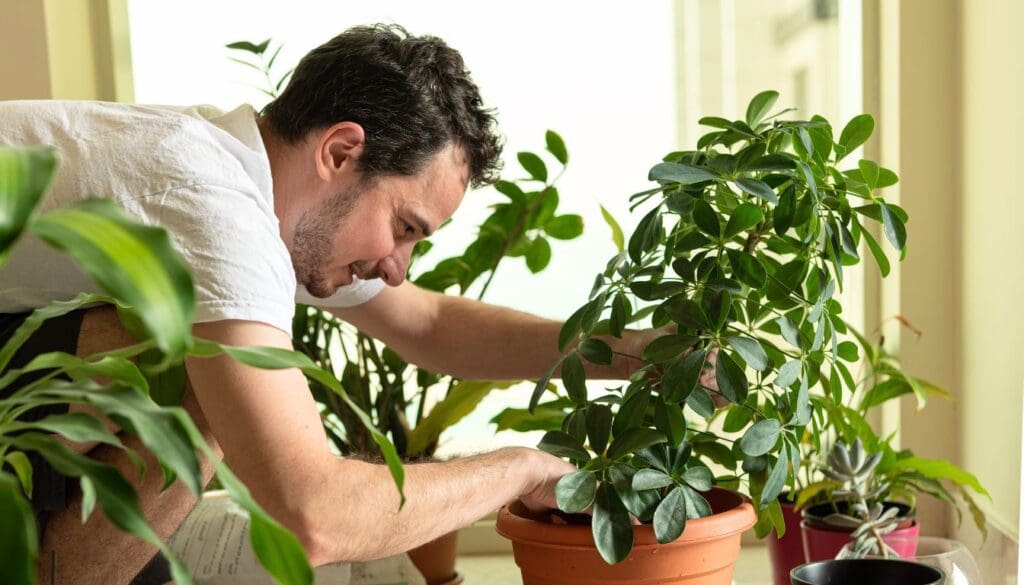
If you want to avoid the above-described problems due to overwatering, you must keep certain points in mind.
- Do not follow a set watering pattern all year round.
- Reduce watering during the fall and winter seasons.
- If you are unsure when to water, always check the soil first to understand if watering is needed.
- Keep your Schefflera in a place with proper light and airflow so that the excess moisture in the soil can evaporate.
- Use a well-draining light loamy soil for your umbrella plant to let the roots breathe and excess water flow off.
- Do not forget to empty the saucers at the bottom.
- Never use pots without drainage holes to grow your plant.
What happens if you underwater your Schefflera?
Schefflera plants are bare drought-tolerant plants, so they can tolerate being under-watered for a while.
Underwatering is less dangerous for this plant than overwatering.
However, if they continue to be underwatered for a long time, it can affect their growth and health and make them weak and dehydrated.
Treating an underwatered Schefflera is easier than treating an overwatered one, so you must look out for the symptoms of underwatering that your plant will show.
- Droopy leaves: Droopy leaves are signs of multiple issues, including underwatering. When the plant does not get enough water for a while, the leaves begin to wilt and droop to save whatever water they have.
- Brown leaves: The leaves turn brown and yellow if the plant stays underwatered. These leaves cannot be turned green again and have to be trimmed off.
- Dry soil: Underwatering will quickly make the soil dry, leading to issues like leaching and dehydrated shriveled plants.
- Crispy leaves: The leaves will become dry and crispy without water and eventually fall off.
- Stunted growth: Lack of water will reduce the plant’s energy to push out new growth, thus slowing down the growth of the plant.
How to prevent underwatering your Schefflera?

Reviving the Schefflera from underwatering is easy.
However, constantly underwatering your plant can seriously hamper its growth.
You must try to prevent this and maintain a healthy watering routine.
- When you see the topsoil 2-3 inches have gone dry, water it.
- Schefflera likes slightly moist soil, so make sure some moisture is left, and the soil is not bone dry.
- If you forget to water your plants often, use an alarm or calendar to remind you.
- While watering, drench the soil thoroughly until the water runs out of the drainage holes.
- Use a self-watering pot if you plan to go on a vacation or don’t have much time.
How do you water your Schefflera?
Here are the steps you can follow to water your Schefflera:
- Check the soil before watering.
- If the soil is dry, fill up water in a container.
- Use rainwater or distilled water for watering. Avoid tap water due to its harmful mineral contents.
- Pour the water on the soil slowly to not put too much force on the soil.
- Water until you see the excess water is running off the drainage hole.
- Then do not water again unless the soil gets dry.
Should I mist my Schefflera?
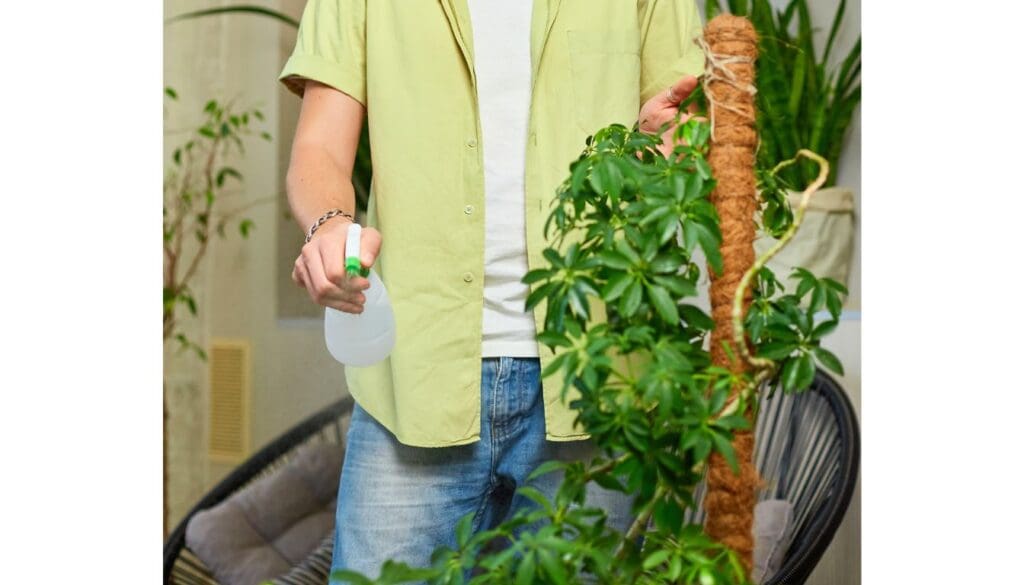
Misting is extremely beneficial for the Schefflera plant.
It helps increase the plant’s humidity, cleans the leaves, and keeps them free of dust and bugs.
This helps the plant to photosynthesize effectively and prevents bugs and pests.
The leaves stay clean and shiny, increasing the visual appeal of the umbrella plant even more.
Final words

Schefflera are an interesting houseplant that is not very finicky, but you must provide their care requirements correctly. They are quite hardy and forgive incorrect watering once in a while.
However, you must not neglect it for a long time, which would negatively affect its health.
When the topsoil gets dry, always check the soil before watering and keep changing the watering schedule as the weather demands. Watch out for overwatering, which causes major trouble to the plant.
Reference: Wikipedia, Sciencedirect, Britannica, American Society for Horticultural Science, Schefflera taxonomic history.
Recommended Garden Supplies
| Product Image | Our Recommended Gardening Supplies | Check Offers! |
|---|---|---|
Top Top
Top
Top
Top
Top
Top
Top
Top | rePotme Houseplant and Tropical Classic Potting Soil Mix | Check Offer On Amazon |
 Top
Top
Top
Top
Top
Top
Top
Top | Espoma Organic Indoor Plant Food | Check Offer On Amazon |
 Top
Top
Top
Top
Top
Top
Top
Top | GooingTop LED Grow Light 6000K Full Spectrum Clip Plant Growing Lamp | Check Offer On Amazon |
 Top
Top
Top
Top
Top
Top
Top
Top | Soil Moisture Meter | Check Offer On Amazon |
 Top
Top
Top
Top
Top
Top
Top
Top | Govee Hygrometer Thermometer, Bluetooth Enabled! | Check Offer On Amazon |
 Top
Top | LEVOIT Humidifiers for Large Room(Best For Plants) | Check Offer On Amazon |
 Top
Top
Top
Top
Top
Top
Top
Top | Upgraded DIY Automatic Drip Irrigation Kit, 15 Potted Houseplants Support | Check Offer On Amazon |
 Top
Top
Top
Top
Top
Top
Top
Top | Stainless Steel Heavy Duty Gardening Tool Set | Check Offer On Amazon |
 Top
Top
Top
Top
Top
Top
Top
Top | Bonide Insecticidal Soap | Check Offer On Amazon |
 Top
Top
Top
Top
Top
Top
Top
Top | Bonide 32 oz Spray Neem Oil for Organic Gardening | Check Offer On Amazon |
 Top
Top
Top
Top
Top
Top
Top
Top | Garden Safe Fungicide | Check Offer On Amazon |

